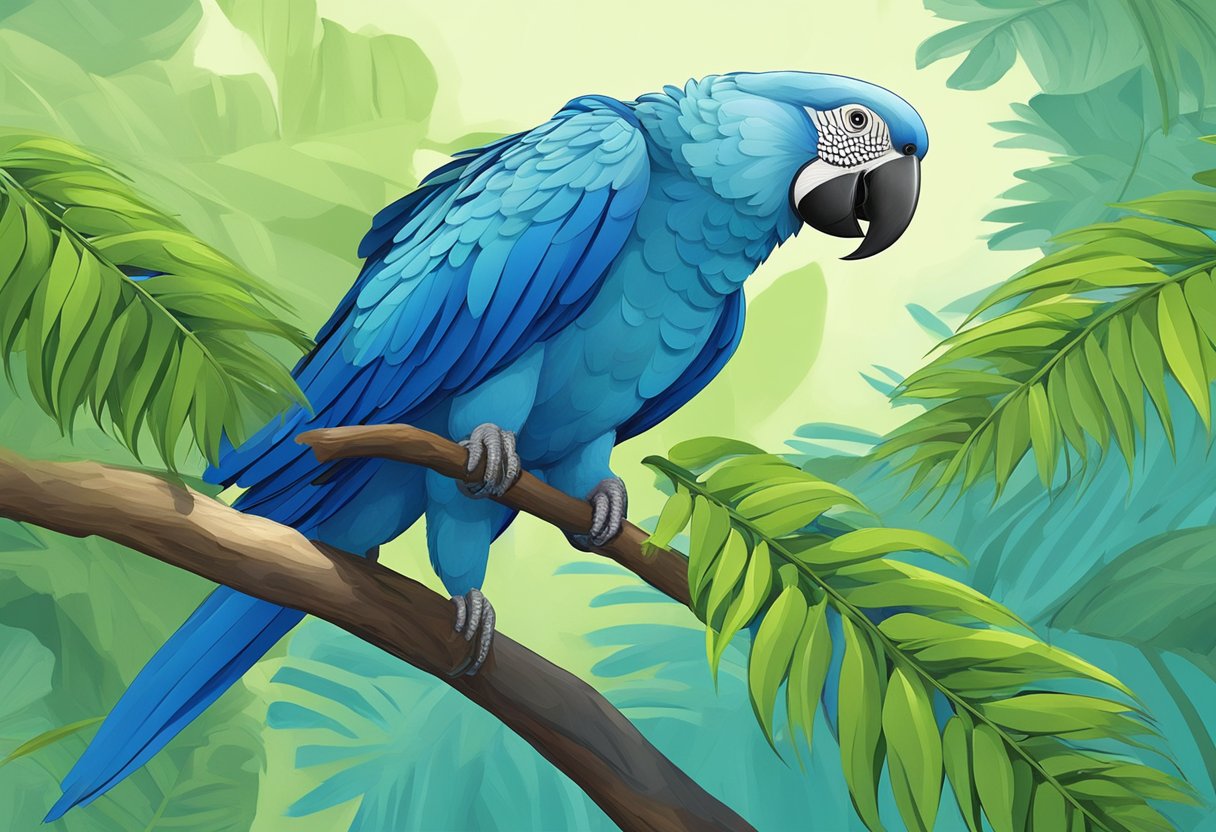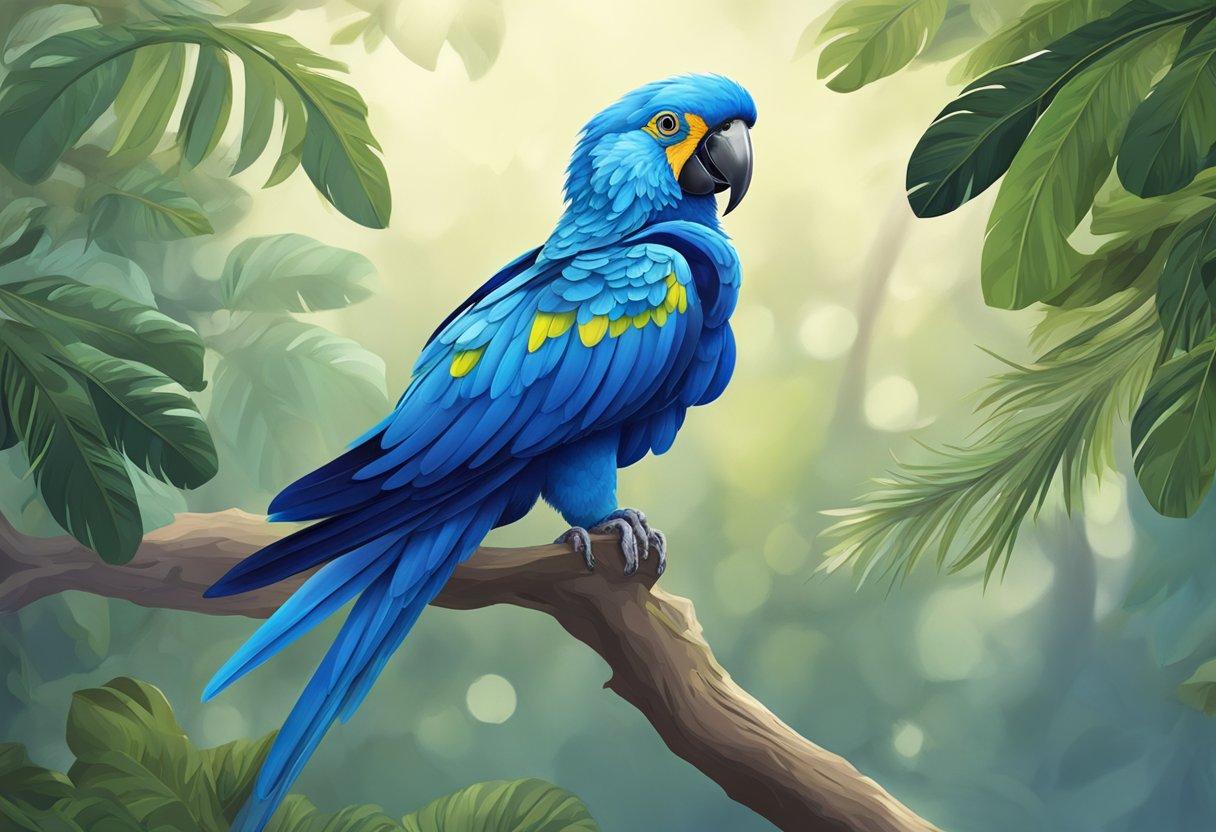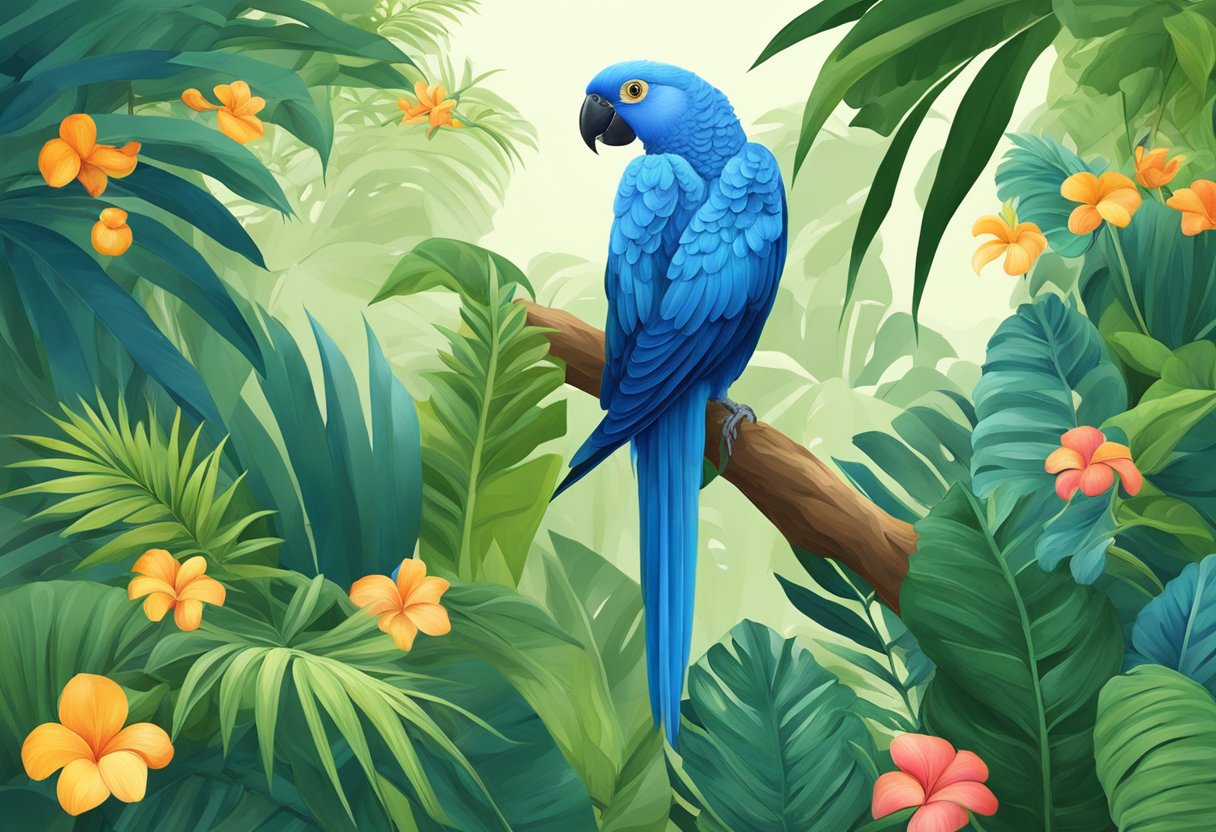Blue parrots are a fascinating species of birds that are known for their striking blue feathers and unique behavior. These birds are found in various regions around the world, including South America, Africa, and Australia. Blue parrots are known for their intelligence, social behavior, and ability to mimic human speech.

Blue parrots are a diverse group of birds that come in many different species. Some of the most common species include the blue and gold macaw, the hyacinth macaw, and the blue-fronted Amazon. Each species has its own unique characteristics and behaviors, but all blue parrots share certain traits, such as their colorful plumage and their ability to communicate with one another.
Overall, blue parrots are a fascinating group of birds that have captured the attention of people all around the world. Whether you are a bird enthusiast or simply interested in learning more about these beautiful creatures, there is no denying the appeal of these intelligent and fascinating animals.
Key Takeaways
- Blue parrots are a diverse group of birds found in many regions around the world.
- Blue parrots are known for their colorful plumage, intelligence, and social behavior.
- Different species of blue parrots have unique characteristics and behaviors.
Blue Parrot Species
Blue parrots are a popular choice among pet bird enthusiasts due to their striking coloration. There are several species of blue parrots, each with their unique characteristics, behavior, and care requirements. In this section, we will discuss three of the most popular blue parrot species.
Hyacinth Macaw
The Hyacinth Macaw is the largest of all parrots and is known for its vibrant blue plumage. These birds are native to South America and can live up to 60 years in captivity. Hyacinth Macaws are intelligent, social, and require a considerable amount of attention and space. They are known for their strong beaks, which they use to crack open nuts and seeds.
Indigo Macaw
The Indigo Macaw, also known as Lear’s Macaw, is a critically endangered species of parrot. These birds are native to Brazil and are characterized by their deep blue feathers and yellow eye-ring. Indigo Macaws are social and intelligent birds that require a varied diet and plenty of mental stimulation. Due to their endangered status, it is illegal to capture or trade Indigo Macaws.
Spix’s Macaw
The Spix’s Macaw is a small, blue parrot that is native to Brazil. These birds are critically endangered, with only a few individuals remaining in the wild. Spix’s Macaws are known for their striking blue coloration and distinctive crest. They are intelligent and social birds that require a varied diet and plenty of mental stimulation. Due to their endangered status, it is illegal to capture or trade Spix’s Macaws.
Overall, blue parrots are stunning birds that require a considerable amount of care and attention. It is essential to research each species thoroughly before deciding to bring one into your home. With proper care, these beautiful birds can make wonderful companions for many years to come.
Habitat and Distribution
Blue parrots are found in various habitats, ranging from tropical rainforests to open savannas. They are known for their vibrant blue feathers and are popular among pet owners. In this section, we will explore the different habitats and distribution of blue parrots.
Rainforest Regions
Blue parrots are commonly found in tropical rainforests, where they thrive in the warm, humid climate. They are known to inhabit the canopy layer of the forest, where they feed on fruits, seeds, and nuts. Some of the rainforest regions where blue parrots can be found include the Amazon rainforest, the Congo Basin, and the Indonesian archipelago.
Conservation Areas
Due to habitat loss and poaching, many blue parrot species are endangered or threatened. As a result, conservation efforts have been put in place to protect their habitats and prevent their extinction. Some of the conservation areas where blue parrots are protected include the Tambopata National Reserve in Peru, the Rio Bravo Conservation and Management Area in Belize, and the Daintree Rainforest in Australia.
Captive Breeding Programs
In addition to conservation efforts, many blue parrot species are also bred in captivity. Captive breeding programs help to increase the population of blue parrots and reduce the demand for wild-caught birds. Some of the organizations that run captive breeding programs for blue parrots include the World Parrot Trust and the American Federation of Aviculture.
Overall, blue parrots are found in a variety of habitats, including rainforests, conservation areas, and captivity. While they are popular among pet owners, it is important to ensure that they are obtained through legal and ethical means to prevent the further decline of their populations.
Behavior and Communication
Blue parrots, also known as blue macaws, are highly social birds that exhibit complex behaviors and vocalizations to communicate with their flock and mate. Understanding their social structure, vocalizations, and mating rituals can help parrot owners better care for their pet.
Social Structure
Blue parrots are known for their strong social bonds and form tight-knit flocks in the wild. In captivity, they require social interaction and mental stimulation to maintain their well-being. They exhibit a variety of behaviors to communicate with their flock, including head bobbing, wing flapping, and vocalizations.
Vocalizations
Blue parrots are highly vocal and use a variety of sounds to communicate with their flock and mate. They can mimic human speech, but they also have their own unique vocalizations, including squawking, screeching, and chirping. These vocalizations can convey a variety of meanings, including aggression, fear, and contentment.
Mating Rituals
Blue parrots have complex mating rituals that involve a variety of behaviors and vocalizations. They engage in courtship displays, such as head bobbing and wing flapping, to attract a mate. Once paired, they exhibit a variety of behaviors to reinforce their bond, including preening each other’s feathers and sharing food.
In conclusion, blue parrots are highly social birds that use complex behaviors and vocalizations to communicate with their flock and mate. Understanding their social structure, vocalizations, and mating rituals can help parrot owners better care for their pet and provide them with the social interaction and mental stimulation they need to thrive.
Diet and Nutrition
Blue Parrots require a balanced diet to maintain their health and well-being. In the wild, they consume a variety of natural food sources, including fruits, nuts, seeds, and insects. In captivity, it is essential to provide them with a diet that closely mimics their natural diet.
Natural Food Sources
Fruits and vegetables should make up a significant portion of a Blue Parrot’s diet. They are a rich source of vitamins, minerals, and fiber. Some of the best fruits for Blue Parrots include apples, bananas, grapes, and berries. Vegetables like carrots, broccoli, and leafy greens are also excellent choices.
Nuts and seeds are also an essential part of a Blue Parrot’s diet. They are a rich source of protein, healthy fats, and other nutrients. Some of the best options include almonds, walnuts, sunflower seeds, and pumpkin seeds.
Dietary Supplements
In addition to a balanced diet, Blue Parrots may benefit from dietary supplements. These supplements can provide additional vitamins, minerals, and other nutrients that may be lacking in their diet. However, it is essential to consult with a veterinarian before adding any supplements to their diet.
Feeding Habits in Captivity
In captivity, Blue Parrots may develop unhealthy feeding habits, such as overeating or consuming a diet that is too high in fat. It is essential to monitor their food intake and provide them with a balanced diet that meets their nutritional needs.
Blue Parrots should have access to fresh food and water at all times. It is also important to clean their food and water bowls regularly to prevent the growth of harmful bacteria.
In summary, providing a balanced diet that closely mimics their natural diet is essential for the health and well-being of Blue Parrots. Including a variety of fruits, vegetables, nuts, and seeds in their diet, monitoring their food intake, and providing dietary supplements when necessary can help ensure they receive the nutrients they need to thrive.
Conservation Status
Endangered Species List
The blue parrot is listed as an endangered species due to habitat loss and illegal trade. According to the International Union for Conservation of Nature (IUCN) Red List, the blue parrot is classified as “vulnerable” and its population is declining. The species is also listed on Appendix I of the Convention on International Trade in Endangered Species of Wild Fauna and Flora (CITES), which prohibits international trade of the species.
Threats to Survival
Habitat loss is the primary threat to the survival of the blue parrot. Deforestation, logging, and agricultural expansion have led to the destruction of the parrot’s natural habitat. In addition, illegal trade is another major threat to the species. The blue parrot is highly prized in the illegal pet trade due to its beauty and rarity.
Protection Efforts
Several conservation efforts are underway to protect the blue parrot. Protected areas have been established to conserve the species’ habitat, and efforts are being made to reduce illegal trade. In addition, captive breeding programs have been established to increase the population of the species and reduce the demand for wild-caught birds.
Overall, the conservation status of the blue parrot remains precarious. Continued efforts are needed to protect the species and its habitat to ensure its survival for future generations.
Physical Characteristics

Blue parrots are known for their striking appearance and unique physical features. This section will explore the plumage, size and weight, and beak and claw features of blue parrots.
Plumage
The plumage of blue parrots is characterized by a range of blue hues, from light sky blue to deep navy blue. Some blue parrots also have green, yellow, or white feathers on their bodies. The feathers on their wings and tails are typically darker shades of blue, providing a beautiful contrast to the lighter feathers on their bodies. Some blue parrots also have distinct patterns on their feathers, such as stripes or spots.
Size and Weight
The size and weight of blue parrots vary depending on the species. The smallest species, the budgerigar, typically measures 6 to 8 inches in length and weighs around 1 ounce. On the other hand, the largest species, the hyacinth macaw, can grow up to 40 inches long and weigh up to 3.7 pounds. Most blue parrots fall somewhere in between these two extremes in terms of size and weight.
Beak and Claw Features
Blue parrots have strong, curved beaks that are well-suited for cracking nuts and seeds, their primary source of food. Their beaks are also used for climbing and grasping objects. Blue parrots have sharp claws that allow them to perch on branches and climb up and down trees. They use their claws to hold onto food while they eat, and to hold onto their mates during mating rituals.
In conclusion, blue parrots have unique physical characteristics that make them stand out from other parrot species. Their beautiful plumage, varying sizes and weights, and strong beaks and claws make them fascinating creatures to observe and care for.
Breeding and Reproduction
Blue parrots are known for their monogamous mating behavior, meaning that they mate for life with one partner. Breeding and reproduction are essential for the survival of the species. In this section, we’ll discuss the nesting habits, egg incubation, and chick development of blue parrots.
Nesting Habits
Blue parrots typically build their nests in tree hollows or crevices. They use their beaks to excavate the nesting site, and both the male and female parrots work together to build the nest. Once the nest is complete, the female parrot will lay her eggs.
Egg Incubation
Blue parrots are oviparous, meaning they lay eggs. The female parrot will lay one egg every other day until she has laid a clutch of 2-4 eggs. The eggs are incubated for around 28 days, during which time both the male and female parrots take turns incubating the eggs.
Chick Development
After the eggs hatch, the chicks are born helpless and rely entirely on their parents for food and protection. The parents will regurgitate food to feed the chicks until they are old enough to feed themselves. The chicks will remain in the nest for around 8-12 weeks before they fledge and leave the nest.
In conclusion, breeding and reproduction are crucial for the survival of blue parrots. They are monogamous and build their nests in tree hollows or crevices. The female parrot lays a clutch of 2-4 eggs, which are incubated for around 28 days. Once the eggs hatch, the chicks are born helpless and rely entirely on their parents for food and protection.
Cultural Significance

Symbolism and Mythology
The blue parrot has held significant cultural and religious importance in various societies across history. In many cultures, the bird’s ability to mimic speech and mimicry is seen as a sign of intelligence and cleverness. It is believed that the parrot possesses ancient wisdom and holds the secrets of the universe within its colorful feathers.
In some cultures, the blue parrot is considered a symbol of freedom, representing the ability to soar above obstacles and challenges. In others, the parrot is associated with love, fertility, imagination, beauty, creativity, and good luck.
Representation in Art
The blue parrot has been a popular subject in art throughout history. From ancient cave paintings to modern-day illustrations, the bird’s vibrant colors and unique features have made it a favorite among artists.
In some cultures, the blue parrot is depicted in religious art, representing divinity, royalty, wisdom, intelligence, and communication. In other cultures, it is used as a decorative motif, adorning everything from textiles to pottery.
Role in Ecotourism
The blue parrot is also an important part of ecotourism in many countries. Visitors from around the world come to see these beautiful birds in their natural habitats, contributing to local economies and raising awareness about the importance of conservation efforts.
In some regions, the blue parrot is threatened by habitat loss, hunting, and the illegal pet trade. Ecotourism provides an opportunity to educate people about the importance of protecting these birds and their habitats, while also providing economic incentives for local communities to participate in conservation efforts.
Overall, the blue parrot holds significant cultural and ecological significance, representing intelligence, beauty, and the importance of protecting our natural world.
Frequently Asked Questions

What features distinguish the BlueParrott M300XT from other models?
The BlueParrott M300XT is a Bluetooth-enabled, noise-canceling headset that features a flexible microphone boom, a padded ear cushion, and a rechargeable battery. It is designed to be comfortable for all-day use and is ideal for use in noisy environments such as construction sites and warehouses. Unlike other models, the M300XT is designed to be worn on either ear, making it a versatile option for users.
How can I pair my BlueParrott B450 XT with my smartphone?
To pair your BlueParrott B450 XT with your smartphone, first, make sure that the headset is turned on and in pairing mode. Then, on your smartphone, go to the Bluetooth settings and search for available devices. When you see the BlueParrott B450 XT listed, select it and follow the on-screen instructions to complete the pairing process.
What are the specialty dishes on the Blue Parrot menu?
Unfortunately, the search results do not provide any information on the menu of the Blue Parrot restaurant. However, it is possible to contact the restaurant directly or check their website for more information.
Can the BlueParrott C400-XT be used with multiple devices simultaneously?
Yes, the BlueParrott C400-XT can be paired with multiple devices simultaneously. This feature is useful for users who need to switch between devices frequently, such as a smartphone and a computer.
What is the battery life of the BlueParrott S650-XT?
The BlueParrott S650-XT has a battery life of up to 24 hours of talk time and 500 hours of standby time. This long battery life makes it an ideal choice for users who need to use their headset for extended periods of time.
What are the unique aspects of the Blue Parrot bar’s ambiance?
Unfortunately, the search results do not provide any information on the ambiance of the Blue Parrot bar. However, it is possible to visit the bar or check their website for more information.
Also read: